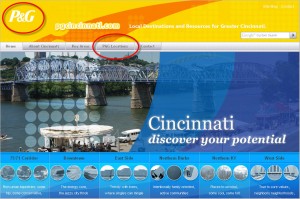This post is really about two different types of “community,” but they are closely connected in the evolving environment of Recruiting 2.0. One is the creation of an online community that attracts and nurtures candidates. The other is the use of location and lifestyle information to attract candidates and nurture new-hires.
I started this train of thought when an interesting tidbit about Proctor & Gamble’s new website focused on Cincinnati—about which more in a moment—came along at the same time I was reading some updates from the recent South by Southwest Interactive Festival. Better known as SXSWi, this gathering attracts both a lot of people and a lot of attention (get the flavor with a CNET roundup), and one of the hot topics this year was virtual/online communities, and the management thereof.
If anyone is thinking “What even is an online community?”, there’s a useful explanation/analysis at trusty old Wikipedia. And if anyone is asking “What does this have to do with recruiting?”, there’s an interesting discussion at EXCELER8ion, which explains that many candidates today have expectations of the recruitment experience based not on what has traditionally been provided by companies, but on the type of experience they have become accustomed to on the web.
Those expectations include a variety of factors (such as snappy design, quick performance, media enrichment, etc.) that have already been very influential in the development of Careers sites. But an additional–and increasingly important–set of expectations has evolved from the connectivity created by social networks, blogs and articles that allow comments, and discussion forums. In short: Many candidates are accustomed to virtual communities and want to find something similar when evaluating a prospective employer.
Creating a virtual community begins with putting the online part in place, but continues with the care and feeding of participants. The second part is called “community management,” and a new area of expertise has developed to meet emerging needs. If you want to get under the hood of what a community manager is/does, check out a couple of community manager blogs: community spark and Kommein.
In terms of recruiting, the EXCELER8ion post suggests that a community manager can have several critical functions:
- As a candidate community advocate, focused on listening, understanding candidate needs, and facilitating social media conversations
- As an employer brand ambassador, spreading positive views of the company and highlighting opportunities through social media channels
- As an analyst/evangelist, who can identify needs and issues, and communicate with both technical providers and business stakeholders to facilitate improvements
Now—what about Cincinnati? As reported in the Business Courier recently, mega-company Proctor & Gamble is building a website that will leverage in-depth information about living in Cincinnati to create interest among job candidates and support for onboarding recruits. It also provides an opportunity to showcase the eight P&G facilities in the area.
In addition to what’s on the current version of the site, P&G reportedly will add about 40% more content before a July launch, including features on company hires who have moved to Cincinnati.
Obviously, Proctor & Gamble is making a big investment in connecting candidates and employees with offline community (aka, the real world). So of course I was curious about their Careers site—and not surprisingly, it is feature rich. But not plugged into the 2.0 world! Apparently P&G is starting to develop a social media agenda, though. Read about their kick-off, and we’ll keep an eye on developments.
Cynthia Giles has followed a serpentine career path from academia to publishing to marketing and design to information technology and corporate communications. There’s plenty of detail about this journey at www.cynthiagiles.com, but briefly--the common theme has been ideas, and how to present them effectively. Along the way, she became an accidental expert on data warehousing and business intelligence, and for the past ten years she has combined corporate contracting with an independent consulting practice that focuses on marketing strategy for smaller businesses and non-profits.
Having spent quite a bit of time looking for work, and anywhere from two weeks to two years inside a wide variety of American companies—she has given much thought to what works (and what doesn’t) when it comes to creating a great employment fit.



